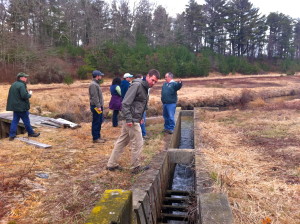We have much more to do and your continued support is needed now more than ever.
Sea-Run Eastern Brook Trout Find Climate Champions at Red Brook
What does a successful on-the-ground climate adaptation initiative look like? Check out Red Brook, Massachusetts.

NWF’s Northeast Regional Center is working with a broad coalition of partners to help sea run brook trout or “salters” at Massachusetts Red Brook-Century Bog complex adapt to the impacts of climate change. Red Brook is a unique spring-fed, cold water, coastal stream that flows roughly 4.5 miles through several former cranberry bogs from its headwaters in Plymouth, MA to the ocean.
“Red Brook is one of the few coastal streams in Massachusetts that supports anadromous fish (migratory fish which hatch in freshwater, make their way to sea to grow, and return as adults to spawn), and is home to one of the last remaining native sea-run brook trout fisheries in the eastern United States”. (Trustees of Reservations)
This one-of-a-kind fishery is under serious threat from climate change. Warming water temperatures and a degraded habitat threaten the long-term survival of these salters. Without a concerted conservation effort it is likely that this unique coastal plain fishery would disappear like so many others along the Massachusetts coastline and beyond.
Fortunately, fifteen state, federal and non-governmental organizations are working together to implement strategies that will help these salters adapt to a changing climate. The efforts include restoring old cranberry bogs to wetlands, stabilizing water flow to prevent thermal “hot spots”, improving water quality, removing several levees, berms, small dams, and dikes, and planting native riparian species along the restored stream channel.
The coalition of partners includes; DFG’s Division of Ecological Restoration (DER) and Trout Unlimited, MassWildlife, A.D. Makepeace, The Trustees of Reservations, the National Wildlife Federation, Manomet Center for Conservation Sciences, the National Oceanographic and Atmospheric Administration, the U.S. Fish and Wildlife Service, the USGS, American Rivers, the Corporate Wetlands Restoration Partnership, University of Massachusetts Boston, Massachusetts Maritime Academy, the towns of Wareham, Plymouth, and Bourne, and DFG’s Division of Marine Fisheries.
The Red Brook-Century Bog initiative has moved beyond partner outreach and into an intensive monitoring phase that will inform which suite of future adaptation strategies will be most effective. The Northeast Regional Center is involved in this process of helping to identify which restoration strategies would be most appropriate.
The exercise of identifying a suite of “climate-smart” strategies is extremely useful at Red Brook and elsewhere as resource managers struggle to implement their projects under the threat of climate change. In many ways, determining these climate-smart recommendations serves to elevate Red Brook as a “showcase” demonstration site for on-the-ground climate adaptation in riverine systems.
To learn more about the development of climate-smart adaptation strategies in the northeast contact me at hilkec@nwf.org.





















